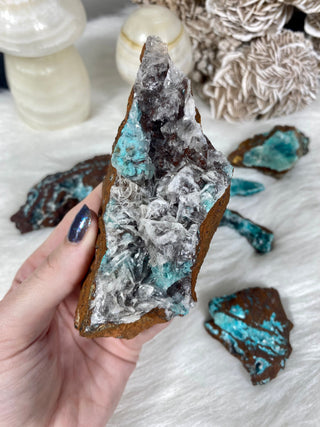Rosasite and Aurichalcite in brown Dolomite matrix. Rich blue spherical Rosasite lives in harmony with the more angular powder blue Aurichalchite. Blades of cool grey Calcite coat the center of the specimen
- Location: Ojela Mine, Durango, Mexico
- Size: L - 13cm, H - 3cm, W - 6cm
Rosasite is a secondary mineral that typically forms as a result of the weathering and oxidation of copper ore deposits. It often occurs as small, rounded blue-green botryoidal (globular) or crusty groups. The color can range from light blue to green-blue. Rosasite gets its name from the Italian mineralogist Francesco S. Rosa, who first identified it.
Metaphysically, it is not in common use although some believe that it can help soothe emotional turmoil, reduce stress, and promote a sense of tranquility. It is thought to resonate with the heart and throat chakras, facilitating clear communication and emotional expression.
Aurichalcite is a copper-zinc carbonate mineral, and it is another secondary mineral that typically forms as a result of the weathering and oxidation of copper and zinc ore deposits. It occurs as delicate, fibrous, or acicular (needle-like) crystals or crusts. Aurichalcite's color ranges from pale blue to green-blue or turquoise.
Aurichalcite is not widely known for its metaphysical or healing properties. However, like Rosasite, some enthusiasts believe that its blue-green color is associated with emotional balance and harmony. It is thought to promote a sense of inner peace and relaxation.
Rosasite and Aurichalcite in brown Dolomite matrix. Rich blue spherical Rosasite lives in harmony with the more angular powder blue Aurichalchite. Blades of cool grey Calcite coat the center of the specimen
- Location: Ojela Mine, Durango, Mexico
- Size: L - 13cm, H - 3cm, W - 6cm
Rosasite is a secondary mineral that typically forms as a result of the weathering and oxidation of copper ore deposits. It often occurs as small, rounded blue-green botryoidal (globular) or crusty groups. The color can range from light blue to green-blue. Rosasite gets its name from the Italian mineralogist Francesco S. Rosa, who first identified it.
Metaphysically, it is not in common use although some believe that it can help soothe emotional turmoil, reduce stress, and promote a sense of tranquility. It is thought to resonate with the heart and throat chakras, facilitating clear communication and emotional expression.
Aurichalcite is a copper-zinc carbonate mineral, and it is another secondary mineral that typically forms as a result of the weathering and oxidation of copper and zinc ore deposits. It occurs as delicate, fibrous, or acicular (needle-like) crystals or crusts. Aurichalcite's color ranges from pale blue to green-blue or turquoise.
Aurichalcite is not widely known for its metaphysical or healing properties. However, like Rosasite, some enthusiasts believe that its blue-green color is associated with emotional balance and harmony. It is thought to promote a sense of inner peace and relaxation.
